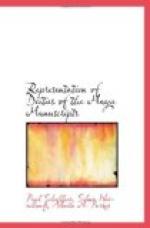In Dr. 65a (middle) B is pictured. But in the text we see K’s hieroglyph presented by a hand. The next figure on the same page at the right represents god B with the head of K on his own and the same head once more in his hand. Agreeing with this, we find in the accompanying text the signs of B and K, the latter in a hand. K seems to be pictured again in Dr. 46 (bottom); the passage, however, is somewhat obliterated. The hieroglyph is lacking in this place; it is found, however, on the preceding page 45 (middle).
In addition to the passage already mentioned, which represents god K together with B, such double deities again occur in the Paris manuscript, p. 13, where B holds K’s head in his hand; in Dr. 34b, where he carries this head on his own and in Dr. 67a where he appears to carry it in a rope. Once, how ever, a variation of these plainly synonymous representations occurs, namely in Dr. 49 (at the top), where we see a feminine form above whose head rises the head of god K. In the Paris manuscript, so far as its defaced condition permits us to recognize the representation, K occurs very frequently, as for example, in Per. 3, 4, 5, 6, 7 and 9 (in part only his head is given, presented by god B, as in the Dresden manuscript).
Brinton considers this figure simply as a special manifestation of B and identical with that god. Foerstemann thinks that god K is a storm-deity, whose ornamental nose, according to the conventional mode of drawing of the Central American peoples, is intended to represent the blast of the storm.
Apparently, however, the deity has an astronomic significance and seems to symbolize a star. In favor of this is the fact, that on the so-called initial pages of the Madrid manuscript (Cort. 22-Tro. 36) a row, composed of repetitions of his sign, occurs below the signs of the cardinal points and parallel to a row composed of signs of god C, the god of the polar star and the north. The hieroglyphs of C and K are the only hieroglyphs of gods, which are repeated 13 times on these pages with the 13 days enumerated there. The two gods must, therefore, have either a parallel or an opposite astronomic and calendric meaning. The fact that in Dr. 25 and 26 K appears as regent of the year, is an argument in favor of his astronomic significance.
According to Foerstemann, Muluc is the day dedicated to god K.




